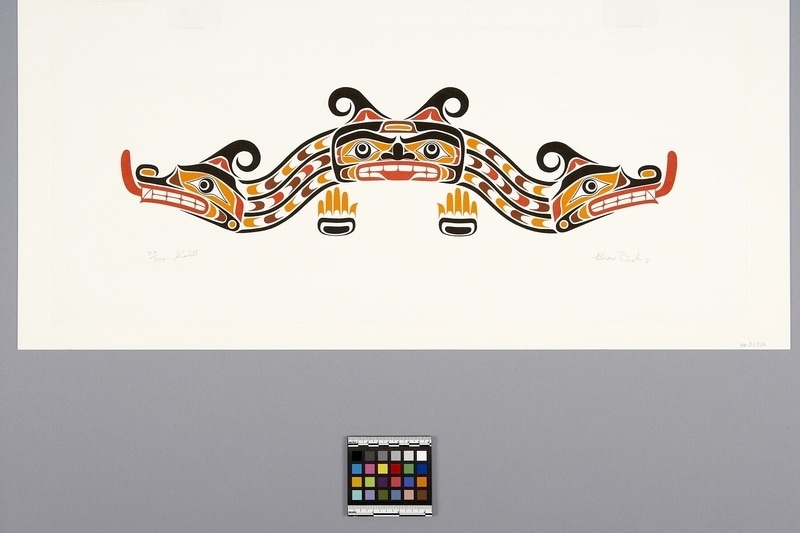Sisiutl Item Number: Nb3.1366 from the MOA: University of British Columbia

Description
Bilaterally symmetrical image with frontal face flanked by profile faces connected by curved band; main lines in black, secondary features in orange-red and orange, tertiary features in brown. Central ovoid face, outlined in black with curled ear-shapes above, circle within circle eyes outlined with tapering ovoids, surrounded by orange. Orange-red mouth, even white teeth, tongue protrudes over centre bottom teeth. Unconnected hands below face on either side with double black ovoid palms and orange fingers and thumb. Curved bands are three thin parallel black bands with rows of u-shapes between, centre u's are reversed from top to bottom; top and bottom in alternating orange and brown; centre alternates in brown and orange-red. Profile faces have curled ear-shape; orange-red tongue protrudes from mouth with even teeth rows, canines are two triangles forming square. Eye as in central face; black nose curves up over central orange ovoid. Pencil inscription at bottom reads '77/200 sisiutl beau dick 81'.
History Of Use
Northwest Coast serigraphs are a contemporary art form, deriving from early 20th century drawings of traditional crest and decorative designs, commissioned by anthropologists and undertaken by artists such as Charles Edenshaw. Residential schools reinforced the medium, while discouraging the use of traditional themes. An important series of traditional designs in coloured pencil and watercolour were done by Mungo Martin for UBC in 1949-50. The 1960's saw the rapid growth of prints, first in unlimited poster editions, and later with the establishment of the Gitanmaax School of Northwest Coast Indian Art at 'Ksan (1967), and of the Northwest Coast Indian Artists Guild (1977), limited edition art runs became the standard. Northwest Coast silkscreen prints are part of the mainstream art market, as well as functioning within the native context as potlatch gifts, and commemorative prints. Although there are distinctive regional styles, individual artists may work in several styles, or apply unique themes and variations to specific works.
Cultural Context
contemporary art
Item History
- Made by Beau Dick (Maker) in British Columbia, Canada during 1981
- Owned by Open Pacific Graphics before September 10, 1982
- Received from Open Pacific Graphics (Donor) on September 10, 1982
What
- Name
- Sisiutl
- Identification Number
- Nb3.1366
- Type of Item
- Manufacturing Technique
- silkscreened
- Overall
- height 29.5 cm, width 68.5 cm
Who
- Culture
- Kwakwaka'wakw
- Creator
- Beau Dick (Maker)
- Previous Owner
- Open Pacific Graphics
- Received from
- Open Pacific Graphics (Donor)
Where
- Holding Institution
- MOA: University of British Columbia
- Made in
- British Columbia, Canada
When
- Creation Date
- during 1981
- Ownership Date
- before September 10, 1982
- Acquisition Date
- on September 10, 1982
Other
- Item Classes
- works on paper
- Condition
- good
- Accession Number
- 0789/0004